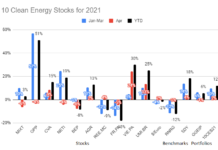Tom Konrad CFA
One irony of green investing is that doing good (for the planet) does not always do well for investors. Recently the rewards for do-gooders have been abysmal. For years, I’ve been warning that the rapid price reductions we need to make solar mainstream are unlikely to be good for the profits of solar companies.
This year a combination of subsidy cuts in Europe and photovoltaic (PV) module oversupply brought those price reductions home to roost. Recently, PV manufactures have been scaling back expansion plans, which should help reign in module supply and the price cuts which are undermining solar manufacturer profitability.
The LED Industry
 |
Light Emitting Diodes (LEDs) are widely assumed to be the lighting technology of the future. LEDs have found their way into televisions and computer monitors, where they are much more energy efficient than the incumbent LCD and Plasma technologies. As I discussed in my March article “Ten LED Stocks, and a Wildcard,” LEDs are also just beginning to enter the consumer market as replacements for incandescent bulbs and Compact Fluorescent Lights (CFLs). While LED based bulbs are still much more expensive than CFLs, they have generally superior performance in several ways: They turn on instantly, are fully dimmable, work well in the cold, and last much longer. LEDs also don’t come with any worries about the small amount of mercury contained in fluorescent bulbs (CFLs included.)
Although LEDs are potentially more than twice as efficient as CFLs (and ten times as efficient as conventional incandescents), my experience with replacement bulbs (I own a half dozen of various types) has been that they are only slightly more efficient per unit light output than comparable CFLs.
LED chips currently produce 100-120 lumens per watt, and typical CFLs produce 60-70 lumens per watt. But it’s clear from the comparison chart from Phillips (PHG) below that the company’s LED based bulbs produce only 48 lumens per watt. That is likely why LED manufacturer comparison charts like the one below only reference incandescents, not CFLs.
![AmbientLED_A-Shape_comparison_chart[1].jpg](http://www.altenergystocks.com/wp-content/uploads/2017/08/AmbientLED_A_Shape_comparison_chart_1_.jpg)
The disappointing performance of LED screw-in bulbs is most likely because LED bulb replacements require normal household alternating current (AC) to be converted to direct current (DC), as well as to be kept cool. These added complexities have so far prevented LED replacement bulbs from achieving their full potential efficiency.
Dr. Roland Haitz (of the eponymous Haitz’s Law the Moore’s Law of the LED industry), quoted in a Cannacord Genuity research note, “views replacement bulbs as a bridge solution and believes that in 20-30 years there will be no more screw-in light
bulbs. He sees fixtures transitioning into more of an integrated solution.”
Given the difficulties of adapting LEDs to a form-factor designed for incandescent bulbs, I’m inclined to agree that replacement bulbs will continue to struggle. Instead, LEDs will continue to make headway in a growing number of lighting niche applications. They already dominate flashlights and other battery powered lighting where their preference for DC current is an advantage rather than a disadvantage. They also dominate in traffic signals, where their directional light and pure colors are an advantage. Continued price reductions will allow them to dominate an increasing number of niches.
Like PV, LEDs have a lot of promise. Yet like PV a couple years ago, they need to see significant price reductions in order to fully achieve that promise. Those price reductions may cause nearly as much turmoil in the LED industry as we’re currently seeing in the PV industry.
Perspectives
 |
How will the coming price drops evolve, and should investors simply avoid the industry, or will there be ports of refuge in the coming storm? I asked three green money managers for their perspectives.
Rafael Coven, manager of the Cleantech Index which underlies the PowerShares Cleantech ETF (PZD), thinks prices for LEDs are likely to fall as fast if not faster than solar PV due to the rapid commoditization of the product. He thinks that as prices fall, “LEDs will start to grab share from halogen lamps first and then decorative incandescent lamps. Eventually LEDs will take share from compact fluorescent lamps where the need for dimming is high, but it will take much longer for LEDs to supplant CFLs because of CFLs longer lamp life/replacement cycle, and the diminished value proposition vs. replacing incandescent lamps with CFLs. … [A]nywhere where labor for lamp replacement is high will be excellent applications for LEDs as well.”
But there are already niches where LEDs have the advantage at current prices. Coven says, “I have already seen long-operating hour applications (e.g., Baltimore’s Mount Sinai Hospital) where LED lamps have already been effectively adapted to replace T8 fluorescent lamps with solid economic returns.”
He thinks most current LED companies will not be able to survive as high volume/low cost producers, so he suggests looking for companies with strong intellectual property that can earn significant profits from licensing, or companies with superior technology which will allow them to charge higher prices.
Garvin Jabusch of Green Alpha Advisors and manager of the Sierra Club Green Alpha Portfolio, thinks that the PV and LED industries are similar in that they have “perceived oversupply issues,” but also rapidly increasing demand. He says, “The macro case for LEDs rests mainly with incandescent bulb sales being banned in the EU, US and China beginning as early as next year, and phasing to complete ban by 2016. This is significant: China alone consumes 1.07 billion incandescent bulbs per year. LEDs aren’t the only alternative but they are the best one in terms of efficiency.”
For ports in the storm, Jabusch points to “upstream play Aixtron AG (AIXG) which makes and sells the machines other firms use to make LEDs, and so provides a way to bet on the industry without selecting individual diode manufacturers. We also l
ike Applied Materials (AMAT) whose LED operations include [high efficiency] LED applications for displays, LED manufacturing software designed to shorten production time, and several other tactical plays hitting multiple verticals and diverse uses. AMAT is also well diversified in other next economy sectors such as advanced materials and energy storage, so it’s an all around good green economy bet.” Green Alpha Advisors and its clients are long both stocks.
Jeff Cianci, Chief Investment Officer at long-short equity fund Green Science Partners sees parallels between the two industries in that both need to drive down prices, but he also sees contrasts. He says “solar needs to consolidate the number of players and LEDs need to consolidate the steps in the value chain for faster adoption.” Cianci thinks the winners will be those that can vertically integrate along the value chain, but they will only be relative winners. He says, “Short term, I don’t see many places to hide.” Longer term, he expects the winners will be acquired by larger industrial technology companies.”
His picks for possible longer term winners are Cree Inc (CREE), or GT Advanced Technologies (GTAT). While GT is a broad based, mostly upstream company like Jabusch’s Aixtron pick, Cianci sees most of the value add in the industry downstream. He thinks that attractive LED fixtures are likely to drive adoption of LEDs, not just price.
Cannacord Genuity. As I was finishing this article, Rafael Coven forwarded me a research note from investment bank Cannacord Genuity. Their LED Analysts believe that investors should avoid upstream names such as Aixtron AG (AIXG) and Veeco Instruments Inc. (VECO), while they have buys on downstream names Cree Inc (CREE), and Acuity Brands (AYI). Their reasoning is that the industry will not need to greatly increase capacity (and hence not need to buy new equipment) even to achieve high penetration of the lighting market. This is in large part due to the extremely long lifetimes of LEDs: the replacement market will be minimal.
Conclusion
These green money managers all agree about the coming difficulty for most LED companies… but there is little agreement about which companies, if any, will do well in the short term. On balance, there seems to be a slight preference for downstream plays, but these stocks may just be the ones which suffer least.
Overall, I think it’s currently safer to be an LED consumer than an LED stock investor.
DISCLOSURE: No Positions.
DISCLAIMER: The information and trades provided here are for informational purposes only and are not a solicitation to buy or sell any of these securities. Investing involves substantial risk and you should evaluate your own risk levels before you make any investment. Past results are not an indication of future performance. Please take the time to read the full disclaimer here.








